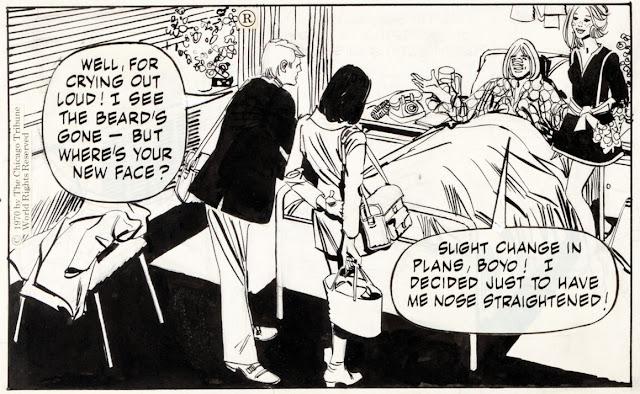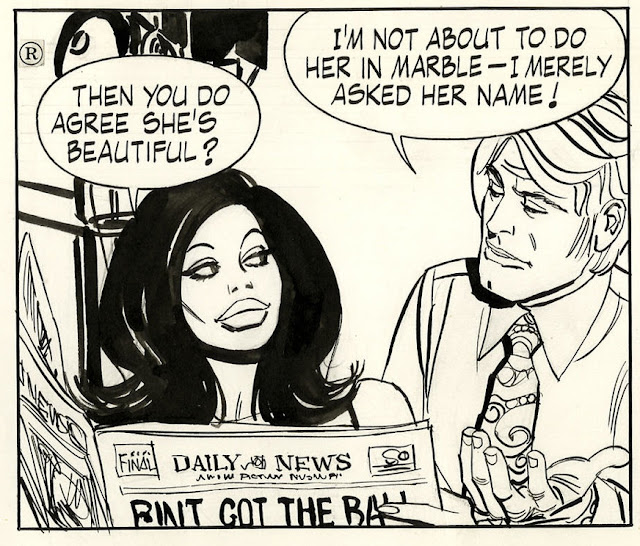Another in the pantheon of well drawn comic strips from this era was Friday Foster, a sharp, stylishly drawn story about the adventures of an African American woman.
Spanish illustrator Jorge Longarón was selected to draw the strip in 1969. Like many other cartoonists of the 60s, he started with the foundation of a photorealistic approach but he also introduced bold patterns at every opportunity-- a combination of African fabrics, fashion illustration and op art.
The 60s were certainly a decade of dramatic change. They were the beginning of the end of these beautifully drawn story strips. They were also a time of change in race relations. In 1961, Leonard Starr introduced a black character into his strip, On Stage, and immediately several newspapers in the south cancelled his strip. Eight years later, Friday Foster became the first major syndicated strip with a black main character.
Longarón went to Harlem to shoot photographs for reference and got a hostile reception from residents suspicious of the man walking around with a camera. The strip ran in a number of papers in the northeast but could never get traction in the south, so perhaps things didn't change all that much after all.














David--another winning entry and what an amazing variety across the spectrum in the four strips individually showcased so far! The astute observations you make on Jorge Longarón's diverse influences in Friday Foster are seldom mentioned elsewhere---too often this strip gets bumped into the column of a sort of late 60's socio-bandwagon curio, with facile comparisons to On Stage and The Heart of Juliet Jones (obviously great touchstones of photo-realistic strips, but through a different lens altogether).
ReplyDeleteAs you point out, Friday Foster was a stylistic departure with its meld of fashion illustration and freeline pen flourishes intercut with of-its-era visual experimentations, which occasionally echo (but never copy) in a less overt manner some of the same elements being explored by Jim Steranko and Neal Adams at the time in comic books. Wonderful to rediscover this all-too-brief gem.
I think Longarón's ability to juggle 3D space, 2D patterning and texture, clear staging, and naturalistic drawing is unparalleled. Certainly, like most of the other 'realistic' strip artists in this series, he was yoked to an artograph or balopticon. But his talent for crisp graphic objects and structural repetitions contrasted against loose artful rendering and casual gestural blocking puts him a cut above.
ReplyDeleteAs comcis artist, I’m concerned by the lack of visual personality of Friday. She doesn’t shine very much. But Longaron’s drawing is very cool.
ReplyDeleteLongaron’s drawings are top notch, other than his treatment of the titular character.
ReplyDeleteFriday doesn’t look like a black woman. Other than her large lips, she is physiologically caucosoidal. It weakens the character, giving her more of a black-face Kardashian look, and makes the whole strip look sickly.
In his defense, this is a challenge that even black comic artists today struggle with. Artist after artist takes characters who are physiologically Uma Thurman and colors the character brown so we understand what race they’re supposed to be.
Black women (other than Ethiopians and Berbers) generally have much larger pupillary distances, shallow brows, foreheads which are less steep, broader noses, heavily lidded eyes, wider cheek bones, etc. Artists would do well to do studies of albino Africans if they better want to understand these facial feature differences in the absence of distracting pigmentation differences.